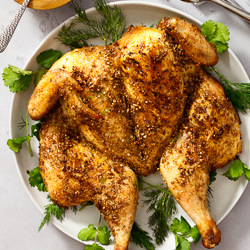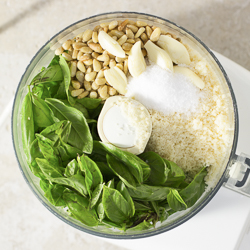It’s a very special time for those of us that love salmon. Why? Because it’s salmon season!
That’s right. From May through the end of September, wild salmon make their way from the ocean back to the rivers and streams of their birth to spawn, with the Pacific Northwest harvest peaking in June and July.
Which means right now is the best time for eating fat, succulent, tasty salmon (like my Pan-Roasted Salmon with Cilantro-Scallion Salsa pictured). Yay!
But enjoying salmon—any time of year—can be confusing. At the fish counter, you’ll likely find different sources and types. And back home, preparing fish can sometimes be, well, daunting. So let’s look at buying, storing, and cooking salmon—the better to enjoy eating it!
Buying salmon
There are basically only two types of salmon—Pacific and Atlantic. Pacific is wild and includes five species. You’ve probably heard of most of them—chinook or king, sockeye, coho, pink, and chum.
There’s only one species of Atlantic salmon, and it’s mainly farmed. But don’t assume that’s a bad thing. It may have been a few years ago, but these days there are many farmed salmon sources recommended by Seafood Watch, the authority on sustainable seafood.
That makes a total of six species, each with its own characteristics. So which should you choose?
I say don’t try to remember whether pink salmon is more delicately flavored (it is) or sockeye has a firmer texture (it does). Simply shop at a fish market with knowledgeable staff and, if they offer more than one option, ask for the characteristics you like—for example, a milder flavor and firmer texture.
Me, I usually ask for whatever is fattiest. Fat means salmon will be both tasty and less likely to dry out or stick during cooking. It’ll also be the most caloric. But when it comes to food, and especially seafood, I’ll take quality over quantity any day.
Because I look forward to enjoying it for years to come, I also want sustainable salmon. So I shop where I know that’s all they carry, I look for the Seafood Watch– or Marine Stewardship Council-approved label, or I consult my Seafood Watch app.
Storing salmon
As I said in this post on tips for delicious fish, once you get home, store your salmon in the coldest part of the refrigerator for up to 2 days—restaurants even put it on a bed of ice. For longer storage, freeze your salmon and, for best flavor and texture, use it within 3 months.
Take salmon out of the refrigerator 30 to 45 minutes before you plan to start cooking, to bring it to room temperature. (This will help keep it from sticking during cooking).
Cooking salmon
Even though salmon tends to be fattier than other fishes, it’s still leaner than other proteins like beef or lamb. That means it’ll cook relatively quickly and that the window between perfectly cooked and dry is relatively slim. So you want to be a vigilant about checking for doneness.
What’s “done”? Perfectly cooked salmon should be just cooked through—with mostly opaque flesh and, if you like, a slightly translucent center (yes, please!). To check doneness without cutting into it, a 3/4- to 1-inch thick fillet should feel barely firm. (See this post for more on how to tell when meat is done by touching it.)
To account for salmon’s relative leanness and quick cooking time, there are two strategies. One, use a short cook and a very hot skillet, oven, or grill to get a nice crust on the outside while keeping it juicy and tender on the inside. My recipe for Pan-Roasted Salmon with Cilantro-Scallion Salsa is an example of this strategy.
Or two, use a moist cooking method, like steaming or poaching. They’re a little more forgiving because the moisture around the salmon keeps the fish tender and juicy even a bit after it’s perfectly cooked. My recipe for Dill-Poached Salmon with Herbed Yogurt Sauce is an example of this strategy.
But no matter how you make it, enjoy it. Get beautiful salmon from good sources, then do right by it at home. That’ll make your salmon worth celebrating now, and all year long.
Salmon recipes worth celebrating:
Pan-Roasted Salmon with Cilantro-Scallion Salsa
Dill-Poached Salmon with Herbed Yogurt Sauce
Grilled Salmon with English Peas and Mint
Salmon Caesar Salad (forgive the photo—it’s from a long time ago!)
Smoked Salmon Salad on Toasts
Other seafood recipes you might enjoy:
Cornmeal-Crusted Petrale with Tomato-Tarragon Relish
Corn and Crab Cakes with Cilantro and Lime Sour Cream
Fillet of Sole with Lemon-Wine Pan Sauce
Halibut with Green Olive Salsa Verde, Arugula, and Lentils











